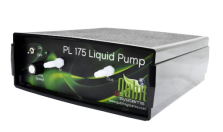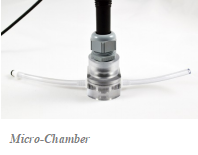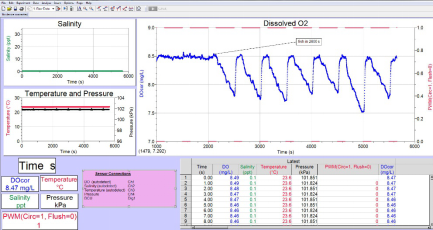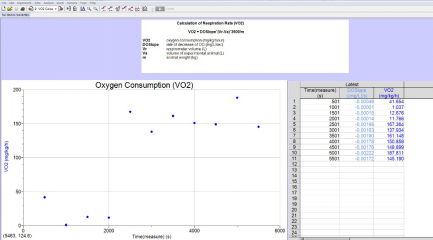 | Introduction The Q-Box AQUA uses intermittent flow respiration to measure the metabolic rate of aquatic animals (both vertebrates and invertebrates).Immediately, aquatic animals are placed in a respiratory chamber to measure metabolic rate by reducing dissolved oxygen.The oxygen consumption rate (VO2) is calculated through software. The original dissolved oxygen data is corrected by salinity, temperature and pressure. The calculation results are displayed and saved in the software. |
 | advantage ComeIntermittent flow respiration method does not require the animals to be taken out of the test chamber, and the measurements are carried out in sequence. The test chamber is rinsed with fresh water between the two measurements, avoiding hypoxia during breathing caused by traditional closed measurement methods. ComeAccurate data, stable readings, simple maintenance; · ComeCan measure automatically for a long time; · ComeThere are different sizes of respiratory chambers to choose from, suitable for measurement of aquatic animals of various volumes ComeAll components are uniformly installed in a solid transport box for easy portability and storage. |
Measurement method
During the experiment, water was circulated through a flow pump in the animal chamber and in a flow container with an optically dissolved oxygen probe.The three-way valve is controlled by a digital control unit (DCU), and the software controls the circulation or flush mode of the system.
Respiratory measurements were performed in cyclic mode, and the animal chamber was flushed with oxygenated water in the water bath in rinsing mode.Loop-flush-loop, repeat until the end of the experiment.The time of the flushing and cycle phases is selected by the user in the software.


mini-AQUA for small samples
For aquatic respiration measurements of small fish and insect larvae (~1g), Qubit offers a mini-AQUA set.The modified Q-Box Aqua comes with a small aquatic respiratory chamber (9ml) and components for smaller system volumes.A mini compartment (1.23 ml in volume) is also included to measure the oxygen consumption rate VO2 of very small samples such as larvae, eggs and juvenile fishes, less than 0.5 g.During the measurement, the micro chamber adopts an intermittent stop flow mode and the dissolved oxygen probe is placed directly in the chamber, thereby improving the sensitivity and resolution of the system.




V4 data channels
VVariable data acquisition rate
VCharts, tables and meter display
VAnalysis Features Suite:
(Statistics, curve fitting, integral, etc.)
VData control devices can be input.
VMulti-page reports can be generated
VData playback function
VSimple formulas can be entered and edited
VAutomatic multiple mathematical functions
VDynamic automatic calculation
Application areas
VResearch on the respiration effects of aquatic organisms (testing the effects of temperature, hypoxia, nutrients, pressure, and body shape on respiration);
VVertebrate and invertebrate studies
VCan be used in the laboratory or in the field
Basic Components
VOptical DO probe and water bath
VSmall breathing measurement chamber (140ml)
VLarge breath measuring chamber (660ml)
VWater bath heated salt probe
VLiquid pump (1 LPM) and 3-way valve
VThree-way valve digital control unit
V4-channel data interface
VData acquisition software
VAbsolute pressure sensor
VStrong weatherproof shell
VOptional battery pack
Technical parameters

Customer Reviews
“We have been using the Q-Box AQUA respirometry package for a year and have been impressed with the quality and versatility of the system. Although designed for teaching, we have found it to be more than adequate for basic research applications on both fish andcephalopods. The mechanical systems are well designed and easily served and the software is intuitive and flexible enough for use in diverse applications. Thetechnicians at Qubit are outstanding; they were able to modify the system to suit our particular needs and they have always been quick to respond when technical support was required. The fact that Qubit ships the system in a protected case was also a big plus for fieldWork!"
form Dr. Tyson Mac C or MAK, biology department, mount Alison university, new Brunswick, Canada
“We have usedQ-box aquaThe breath measurement software package has been a year and it has impressed us with its quality and versatility.Although designed for teaching, we found that it is sufficient for basic research applications of fish and cephalopods.The mechanical system is well designed, easy to maintain, and the software is intuitive and flexible, and is suitable for a variety of applications.Q UB ITThe technicians are excellent; they are able to modify the system to meet our special needs and the technical support is responsive.Q UB ITThe system is installed in a protection box, which is very beneficial for outdoor work!
Publish a document
·Bessemer RA et al. (2015) Cardiorespiratory toxicity of environmentally relevant zinc oxide nanoparticles in the freshwater fish Catostomus commersonii. Nanotoxicology 9: 861-870
·Callaghan NI et al. (2016) Zinc oxide nanoparticles trigger cardiorespiratory stress and reduce aerobic scope in the white sucker, Catostomus commersonii. Nanoimpact 2:29-37
·Black MN et al. (2017) Environmentally relevant concentrations of amine-functionalized copper nanoparticles exhibit different mechanisms of bioactivity in Fundulus Heteroclitus in fresh and brackish water. Nanotoxicology 11:1070-1085
·Keogh CET AL. (2017) the double edge to parasite escape: invasive host is less infected but more infected able. ecology 98:2241-2247
·Rangel RE, Johnson DW (2018) Metabolic responses to temperature in a sedentary reef fish, the bluebanded goby (Lythrypnus dalli, Gilbert). Journal of Experimental Marine Biology and Ecology 501: 83-89
Lamarre SG et al. (2019) Interrelationship Between Contractility, Protein Synthesis and Metabolism in Mantle of Juvenile Cuttlefish (Sepia officinalis). Frontiers in Physiology V10, 1-14 (doi: 10.3389/fphys.2019.01051)
Origin: Canada